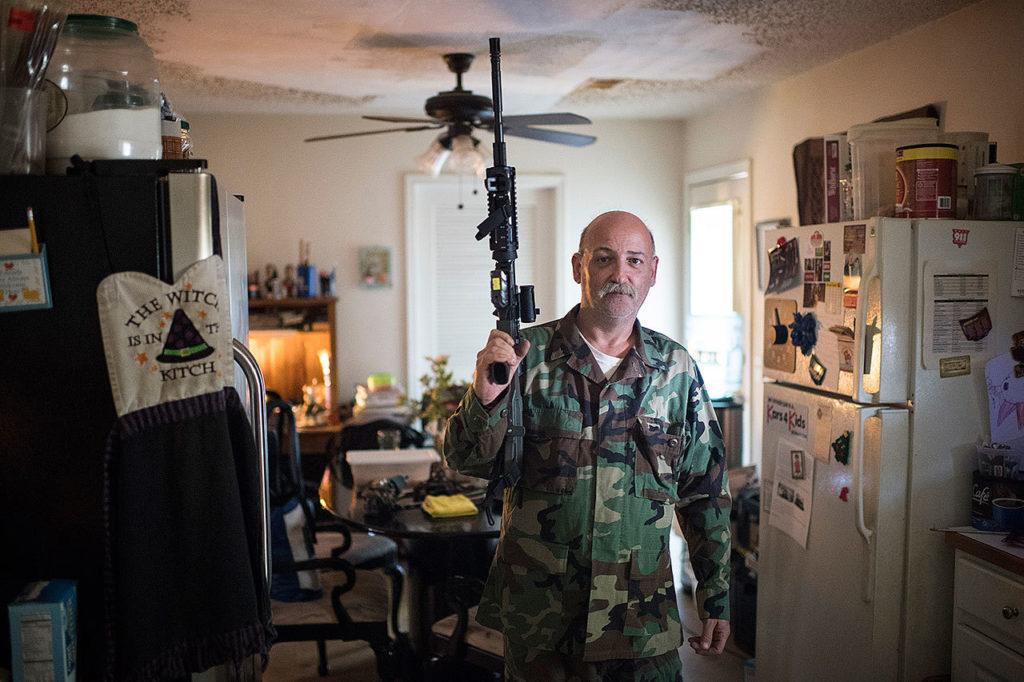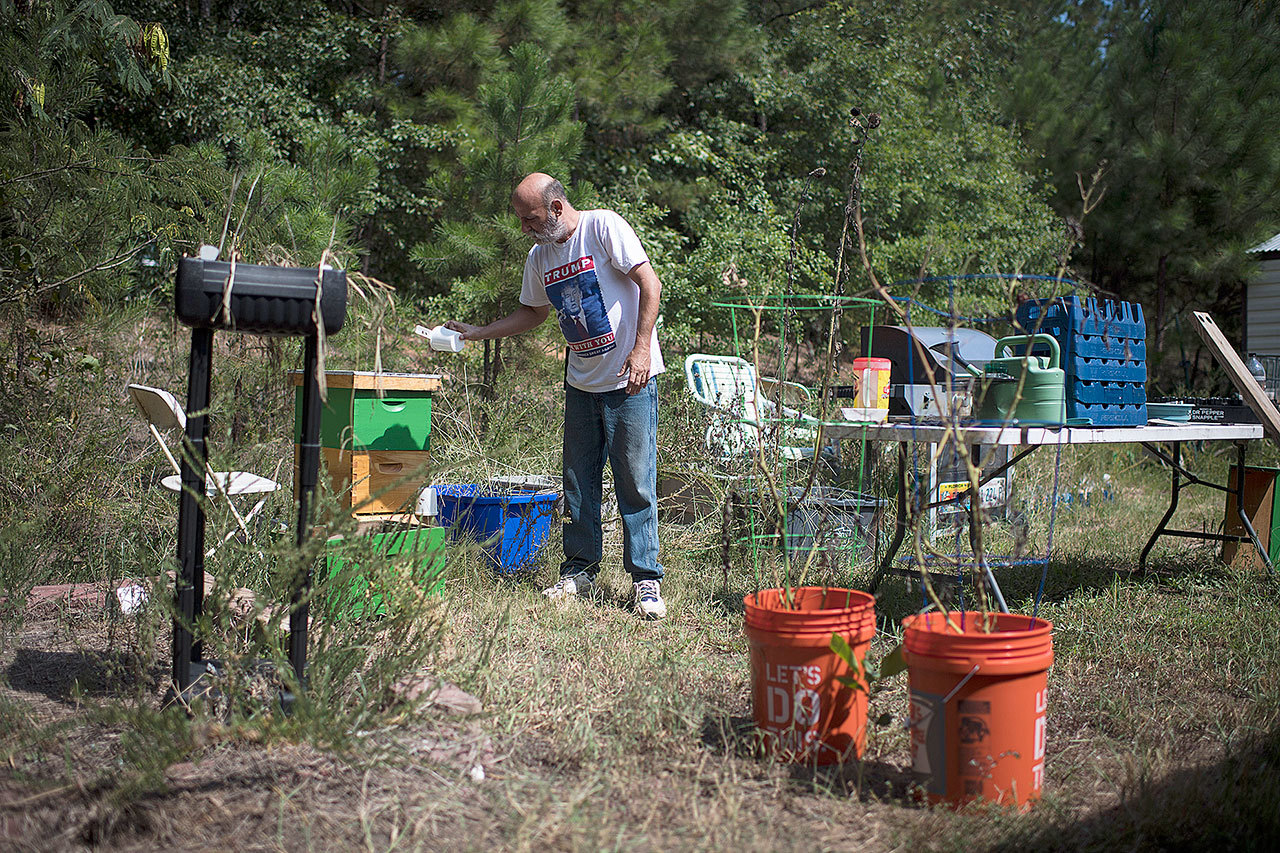By Terrence McCoy, The Washington Post.
WINDER, Ga. — All Jim Cooley wants to do is buy some soda.
“You want to come to Walmart?” he asks his wife.
“No,” Maria says.
“Pretty please?” Jim asks.
“I’m not going to sit there and have the police called on you. I mean, I don’t want to see that crap,” Maria says, knowing what a trip to Walmart means. She knows her 51-year-old husband has two guns inside the house, and this afternoon it won’t be the 9mm, which he straps on with a round in the chamber when grabbing lunch at his favorite fast-food restaurant or visiting a friend’s auto shop. It’ll be the AR-15 semiautomatic rifle, which he brings when going somewhere he thinks is dangerous, like the Atlanta airport, where he’s taken it loaded with a 100-bullet drum, or Walmart, where he thinks crowds could pose an easy targets for terrorists.
In a country of relaxing gun laws where it’s now legal to open-carry in 45 states and there are 14.5 million people with carry permits, every day seems to bring a new version of what open carry can mean. In Kentucky, it’s now legal to open-carry in city buildings. In downtown Cleveland, people carried military-style rifles during the Republican National Convention. In Howell, Michigan, last month, a father went openly armed to his child’s middle-school orientation. In Mississippi, it’s now legal to open-carry without a permit at all. And in Georgia, which has passed a “guns everywhere” bill and has issued nearly 1 million carry permits, Jim Cooley is staking out his version of what’s acceptable as he keeps pleading with his wife.
“I got to get soda.”
Maria sighs. She worked the night before assembling air-conditioner compressors at a nearby factory, and in a few hours, she knows she’ll have to leave for another third shift.
“Yeah,” she says, giving in. “I might as well get this travesty out of the way.”
“What travesty?”
“You carrying a big ol’ rifle in the store, scaring the hell out of all the Walmart shoppers.”
“There’s no difference between carrying a rifle and carrying a handgun,” he says.
“You tried that last time, remember?” Maria says, stepping into a pair of flip-flops and running her fingers through her hair. “And what happened? Barrow County sheriffs. Three or four of them.”
“They can’t tell me what and what not to carry,” Jim says. “You know I wouldn’t listen to them anyway.”
“Well, you go one way in the store; I’ll go the other,” Maria says. “Then when they say, ‘Ma’am, do you know this person?’ I’ll say, ‘No, I’ve never seen him before in my life.’ “
He places a lit cigarette into an ashtray, walks into his bedroom, reaches behind its door, picks up the AR-15, snaps in a magazine with 15 rounds, and slings the rifle around his left shoulder so it rests against his torso.
“Ready?” he asks.
“Yeah,” she says, grabbing her purse and following her husband out the door for an afternoon trip to Walmart to buy soda.
– – –
The gun Jim Cooley carries is the ATI Omni-Hybrid Maxx AR-15 semiautomatic rifle. It cost him $579.99. It weighs 6.25 pounds, is 35 inches long, and fires bullets as fast as the trigger can be pulled, and, as Jim has learned, fits nicely between the front seats of a white minivan with peeling paint on the front and a bumper sticker on the back that says, “I (heart) Law.”
Jim goes everywhere now with a gun — if not the AR-15, then his sidearm — and is so reliant on one being close by that it surprises him to think the majority of his life was lived otherwise. He was raised in a working-class family in Chicago, where he can’t imagine living now because of its strict gun laws. But they didn’t bother him then. He didn’t hunt. He didn’t fear for his safety. If his dad had a gun, no one knew. He grew up without a gun, went to church without a gun, married Maria without a gun, began raising two children without a gun, and settled into a life that felt as safe as it was dependable.
But then it began unraveling, starting when he was fired from a trucking job days after telling Maria, who was pregnant with their first child, to quit her job and focus on the baby, that he could support them both. Their first bankruptcy filing wasn’t far behind, then the second, and the third, and then they were moving to Florida, where Maria had family and where Jim got a job with a grocery chain. It transferred him to Winder, and he moved the family into a middle-class neighborhood struggling with crime and drugs.
Jim now steers past the house of a neighbor who sold him his first gun — a .380 semiautomatic for $100 — so he could protect his family from that crime, then past Winder’s only gun shop where he took his dad so he could buy a gun, too. He lights a cigarette, feels the breeze from an open window because the air conditioner is broken, and takes a sip of soda from a big mug that says Athens Regional Medical Center.
It’s a memento of sorts from the day in late 2008 when he emerged from that hospital with three stents in his heart, debts worth $41,052.51 and a dawning realization he was now disabled, broke and would never work again. After the heart attack, he lost most of the circulation in his legs, received three more stents and started using an electric scooter whenever he had to walk long distances.
He told Maria he was all used up, a drag on the family. She should think about leaving him. But she wouldn’t, even after the hospital sued him for unpaid medical bills, even after he was arrested when he carried his .380 outside a school board meeting, even after he came home one day with an AR-15. He shot it at a nearby firing range and, feeling a sense of control that had gone missing in his life, told Maria he could now keep the family safe.
She now sits at his side, as always, in the passenger seat. At first, she didn’t understand the changes she saw in the man she married 24 years ago. Why did he suddenly want a gun when he never mentioned one before? Why did he want her to get one, too? Why did he put two four-inch knives inside the car’s passenger-side door? And why all the security cameras? Maria glances at a small screen beneath the rearview mirror: It shows feeds from surveillance cameras affixed inside the car that start recording when someone turns the ignition.
– – –
But Maria went along with all of it. She bought a .380 semiautomatic and has gotten used to taking it with her wherever she goes. She got used to the cameras, too, including the seven Jim placed around the house’s perimeter. She began to understand why he was so concerned about crime, about terrorists, about the need to protect their family because they couldn’t count on the government to do it for them. Last year, when he showed her his new AR-15 and asked her to shoot it, she did, feeling intimidated afterward. But then she did it again. And when he started bringing the rifle not just to the range, but to Atlanta, to the airport, inside Walmart, she eventually went along with that, too.
So much of her life involves accommodating him now, including just before they left for Walmart and he asked her to send a Facebook message to a local deputy about his plans. “What do you want me to tell him?” Maria had asked.
“Say, ‘Hey, buddy, I’m going to Walmart, and I’m going to have my AR with me, so if any call comes over the radio, you know it’s me,” Jim told her.
Maria sat at a laptop in a bedroom cluttered with stacks of documents, some of which detailed foreclosure proceedings against the house, and saw the browser had 35 tabs open. One was a YouTube video of something called “Police State 101.” Another showed the dictionary definition of the word “law.” Another was a fringe website her husband classifies as “underground,” the sort he started visiting more frequently after he joined a Georgia militia in late 2014 and decided it was up to him to protect his family from foreign and government threats.
She messaged the deputy, then looked at Jim’s Facebook page. It bore pictures of her husband carrying guns and posts about a country dissolving into chaos and videos about people stopping intruders with guns, people killing burglars with guns, people shooting big guns, small guns, all kinds of guns, that he watches late into the night.
She came back to the kitchen table, where Jim sat and smoked.
“At least I notified the sheriff’s department ahead of time,” he said. He looked at Maria. “Come on, come to Walmart with me,” he said. “I got to get soda.”
So she went along with that, too, and now here she is, pulling into a parking spot outside Walmart, and her husband is reaching for an AR-15 that he tells her sometimes he would have no problem using against a thief breaking into their house, or a violent protester in the streets of Milwaukee, or a terrorist in Syria, or, if necessary, even a stray dog on their lawn.
– – –
The Walmart Supercenter is outside of downtown Winder, next to the Subway, the Great Clips, the GameStop, and buffered by a parking lot that can easily fit hundreds of cars, but is rarely more than half-full on weekdays. There are two entrances. One is beside the landscaping section and says “Home and Garden” above the doorway. The other, which Jim now walks through, leads to another Subway, this one just inside the supercenter.
As Maria goes ahead, Jim veers to the right, where he climbs into a complimentary electric scooter, repositions his AR-15 so its barrel points toward the scuffed vinyl floor, and rolls into the store.
“Hey, Maria,” he calls when catching up to her. “Do we need any lunch meat?”
“I’ll go get some salami,” she says.
“All right,” he says, now alone, and accelerates the scooter deeper into the store, crossing into the grocery section. Two middle-aged women stand beside a refrigerator, talking. One of them looks at Jim, sees the gun around his neck and goes silent. The other woman turns, and when she sees the gun, her expression freezes, too. But it’s not the fearful looks that Jim notices as he rolls past. It’s a nearby sale. “Eighty-eight cents for a loaf,” he says and keeps moving toward the back of the store.
Not everyone sees his AR-15, which is partially obscured by the cart. One man walks past without a second look. So does a woman, making her way into the clothing section. One couple give Jim wide berth, their eyes on his scooter and, briefly, his gun. And then Jim gets where he’s going — the soda aisle — and sees what he’s looking for.
He reaches out and, grunting, pulls free a 24-pack of Diet Dr. Thunder. Trying not to jostle the AR-15, he leans forward and, twisting awkwardly, drops the box into the scooter’s front cart, accidentally tearing it open.
“They don’t make these things like they used to,” he says quietly and grabs another 24-pack of Diet Dr. Thunder, placing this one inside the cart more gently.
In search of Maria, he continues into the dairy section, where he wheels past a father and his young daughter who stares at his rifle, into aisle 9, where he puts a large can of Great Value Classic Roast Coffee into his cart, and finally back to the front of the supercenter, where he sees Maria ordering salami.
She takes the soda and coffee out of his cart and places it in her own. She gestures at a nearby cheesecake. “They got strawberry swirl,” she says.
He is leaning forward. The muzzle of the loaded gun is pressing against his shoe. Now it’s sliding under his shoelaces.
“Give me the strawberry swirl,” he says, and as Maria heads toward the checkout line with the cheesecake, the salami, the coffee and the soda, he straightens up and the muzzle slides free of his shoe.
He steers toward the front doors, parks the scooter, slowly stands and walks outside, and that’s when a group of employees standing just outside the entrance notices the gun.
“Is that what I see?” one will later recall saying.
“What do we do if he comes in the store?”
“If someone feels uncomfortable, what can we do?”
They continue staring as Jim walks into the parking lot toward the car.
“You know my grandfather was murdered, right?” one of the employees says, and as they launch into a discussion of a robbery and shooting that happened in 1973, they are in the midst of a late summer afternoon in 2016 with its own set of shootings.
In California, by the end of this day, a 61-year-old man will have been shot to death at a carwash.
In Virginia, an intruder will have burst into a home and killed a 24-year-old man inside.
In Missouri, a woman will have shot and killed a man she said was chasing her.
And meanwhile, in Georgia, Jim is braking hard on the ride home, causing his AR-15 to topple forward.
“Can you hold onto that for me, please?” he asks Maria.
“Yeah,” she says, putting the gun back where it was, and without further incident they continue on their way home, where Jim puts away his AR-15, sits down at the kitchen table and takes a drink of Diet Dr. Thunder.
Talk to us
> Give us your news tips.
> Send us a letter to the editor.
> More Herald contact information.




























